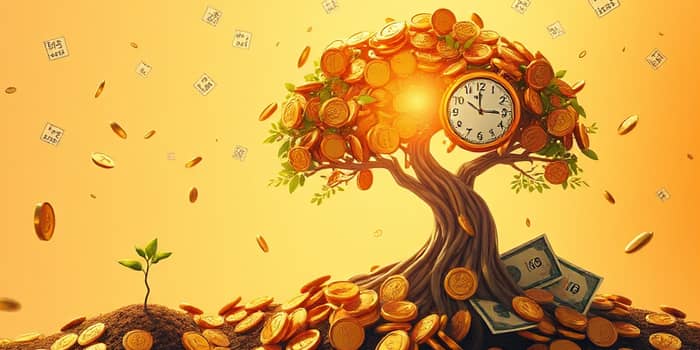Compound interest is often hailed as one of the most transformative financial principles available to individuals at every stage of life. By reinvesting earned returns, your money doesn’t just grow—it accelerates its own growth in a ripple effect that can turn modest savings into substantial wealth over decades.
The Difference between Simple and Compound Interest
At its core, simple interest calculates earnings solely on the original principal, resulting in a linear increase over time. In contrast, compound interest builds on both the principal and previously accumulated interest, creating an exponential trajectory.
For example, a $10,000 deposit at 6% simple interest yields $600 each year, totaling $6,000 in a decade. But with monthly compounding at the same rate, that same deposit grows by the reinvestment of earned interest, producing about $11,819 over ten years—nearly double the simple interest outcome.
The Power of Compounding
Compound interest harnesses the extraordinary effect of exponential growth. As interest is credited and immediately begins earning additional interest, the growth curve steepens. Over long periods, even small principal amounts can yield impressive totals.
Imagine investing $5,000 at 5% interest compounded annually. After 20 years, it becomes roughly $13,266—more than double your initial capital, thanks to exponential growth over time. The longer you wait, the sharper the upward curve.
The Formula and Its Components
The standard formula for compound interest is: A = P (1 + r/n)ⁿᵗ, where:
- P = initial principal
- r = annual interest rate (decimal)
- n = compounding frequency per year
- t = time in years
- A = accumulated amount after t years
Each variable plays a crucial role. Increasing the rate (r) or frequency (n), or extending the time horizon (t), can dramatically boost the final amount (A). Understanding how these factors interrelate empowers you to make informed decisions about where and how to allocate your funds.
Effects of Compounding Frequency
Interest can be compounded annually, semi-annually, quarterly, monthly, daily, or even continuously. The more frequent the compounding, the greater the yield, since interest is calculated and added back to the principal more often.
This table illustrates how shifting from annual to daily compounding yields an extra $244 over ten years—a modest boost, but one that becomes significant at higher balances or rates.
The Importance of Time
Time is the most potent ingredient in the compound interest recipe. The earlier you begin investing or saving, the longer your funds can benefit from the compounding process.
Consider three savers each contributing $200 monthly at 6% annual interest:
- Starter at age 25, saving for 40 years: ends with approximately $385,000
- Starter at age 35, saving for 30 years: ends with about $180,000
- Starter at age 45, saving for 20 years: ends with roughly $87,000
These contrasts underscore why it’s vital to start saving as early as possible—your contributions have more time to snowball.
Real-Life Applications
Compound interest permeates many financial products. Savvy individuals leverage it to build wealth, while borrowers should be cautious when debt carries compounding charges.
- Savings accounts and high-yield online accounts
- Retirement vehicles: 401(k), IRA, Roth IRA
- Investment portfolios reinvesting dividends
- Credit cards and loans (compounding can work against you when balances aren’t paid in full)
Strategies to Maximize Compound Interest
To harness compound interest effectively, adopt these best practices:
- Begin contributions immediately, even if small.
- Be consistent with deposits to maintain momentum.
- Reinvest all interest and dividends without withdrawal.
- patiently let money grow over long periods to reap maximum rewards.
- Diversify investments to balance potential returns and risk.
Compound Interest and Wealth Building
Over decades, compound interest transforms disciplined savers into substantial shareholders. Many financial advisors point to it as the single most powerful path to building wealth available to everyday investors.
Reinvesting dividends and interest payments within a diversified portfolio—stocks, bonds, and other assets—can accelerate growth, creating a cycle of increasing earnings and larger future contributions.
Pitfalls and What to Watch Out For
While compound interest is a friend to investors, it can be an enemy when linked to high-interest debt. Credit card balances that compound monthly or daily can escalate quickly if left unchecked.
Additionally, premature withdrawals from accounts interrupt the compounding sequence and reduce final outcomes. Cultivate discipline and an understanding of terms to prevent these common mistakes.
Conclusion
Albert Einstein reputedly dubbed compound interest the “eighth wonder of the world” for its capacity to amplify modest sums into significant fortunes. By comprehending its mechanics and implementing disciplined strategies, you can unlock the full potential of your savings and investments.
Embrace the principle of compound interest early, remain patient, and watch as your money embarks on a journey of growth that accelerates with each passing year.
References
- https://www.td.com/ca/en/personal-banking/advice/growing-money/what-is-compound-interest-and-how-does-it-work
- https://www.investor.gov/additional-resources/information/youth/teachers-classroom-resources/what-compound-interest
- https://www.investopedia.com/terms/c/compoundinterest.asp
- https://en.wikipedia.org/wiki/Compound_interest
- https://byjus.com/maths/compound-interest/
- https://utxcu.com/how-to-use-compound-interest-to-build-wealth/
- https://www.westernsouthern.com/investments/how-does-compound-interest-work
- https://www.consumerfinance.gov/ask-cfpb/how-does-compound-interest-work-en-1683/










